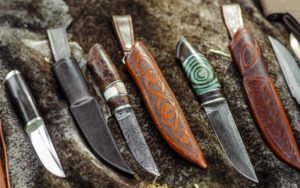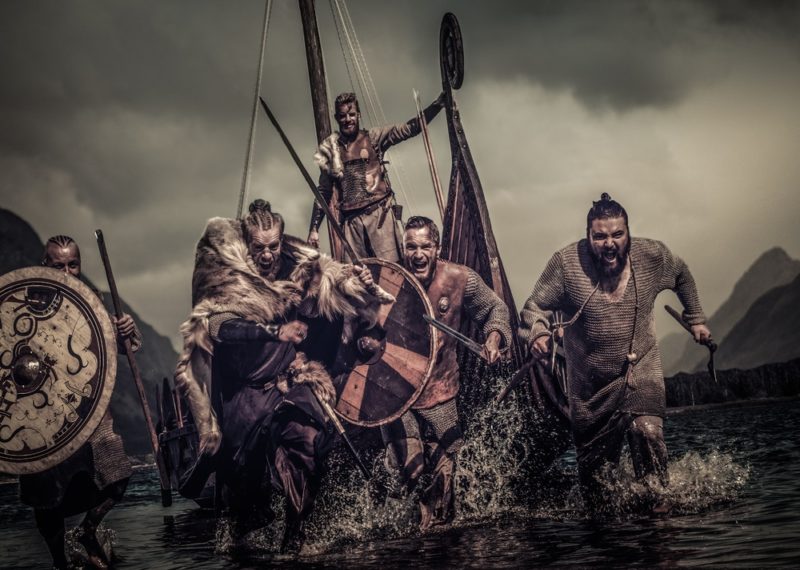A Viking knife was so much more than a blade or weapon. To Viking tribes, working with your hands and the land together was how you survived and thrived. The chances are that most Vikings picked up their first knife long before they could put a sentence together.
Making and using knives was an artform in Viking times. These tools were arguably the most important items a Viking would wear. The pride with which a sword or knife was forged, carved, worn, and even buried shows us that they really loved their blades.
History of the Viking Knife
Finding a Viking knife or sword is a rare and exciting moment, and whenever it happens we learn so much more about the culture. A blade of some kind shows up in almost every Viking grave, from kings to slaves. This fact alone speaks volumes.
When an extremely rare Viking sword is found, as happened in Scotland in 2015, history becomes ever clearer. Finds like this show us that warriors would wear highly decorated and intricate blades- not only the simple steel single-edge blades that we know more about.
One thing is for sure. There was no limitation on who could use a knife, with men, women, and children alike sporting some kind of blade. Throughout Norse mythology, blades play central roles in some of the most important events and stories.
Essential Qualities of a Viking Knife

Full Tang Blade
Full-tang knives have a blade that goes all the way to the base of the handle. They usually have the best balance and are far more durable. If you are buying a Viking knife to use for hunting, a full-tang blade is the best quality.
Very Nice Weight
A heavy knife can be a little distracting and difficult to use freely. Walking around outdoors in the heat was just as tiring for the Vikings, and they were on the move a lot. Their knives were probably substantial enough to pack some punch but light enough to be convenient.
Sharp Steel
A sharp steel blade is a must. Both the edge and the tip of the knife should be able to cut easily and effortlessly without making a mess of things.
Functional Handle
The handle makes it possible to even use a knife, so it should not be overlooked. Your choice of material when picking a handle is important, as you need to feel comfortable holding it. Wood was a very popular material for handmade knife handles back in the Viking days, and it is still pretty popular now.
A handle should be at least the same width as the blade with something to protect your hand from slipping and coming into contact with the steel.
Types of Viking Knives
Seax
The seax is the most iconic Viking knife of all. Its wide blade with a dramatically slanted edge was the sword of choice in many a battle. You can find replica reenactment weapons of this kind through specialist dealers.
Tool Blade
Vikings weren’t just about fighting you know- they were also pretty handy! A simple tool blade was a must-have item for any Viking big enough to hold one, regardless of gender, age, or status.
Clip Point
Clip point knives have a menacing look about them. The end hooks down to create a sharp point that any enemy would be hesitant to face.
Straight Knife
These essentially look like small swords and were the weapon of choice for many female Viking warriors. Aerodynamic and easy to work with: the Viking straight knife was a force to be reckoned with- as were Viking women.
Questions and Answers about the Viking Knife
What were knives used for in Viking times?
Knives were and always have been highly multi-functional tools. The Vikings were people of the land and excellent at manual labor and creativity. Many Vikings likely used knives to hunt, fish, eat, carve, and fight.
Think of knives as the Viking’s must-have items whenever they left home. According to history, these sharp little tools were part of the Norsemen’s armor and everyday attire, and they would rarely head out without one.
Did Viking women use knives?
Oh, yes! The Vikings were ahead of the times when it came to understanding that women are every bit as powerful as men and can be significantly more fearsome if they want to be. Furthermore, the blades found in most female graves are mostly small straight knives that could be useful for hunting- both food and enemies.
A classic Viking seax is not often found in a female grave, which may suggest they were more of a boy’s toy.
Can I buy a hand forged Viking knife in the US?
Yes, you can, but it depends on the style. Under the right to bear arms laws country-wide, there are variations on what knives you can and can’t carry around- we are not in 9th Century Scandinavia after all. The US has many licensed sellers of handmade Viking knives.
Depending on what category of knife you are interested in, there are different rules and regulations. Most seax replicas are reenactment weapons that can only be sold with a dull edge. Small hand-forged carving or hunting knives, on the other hand, are readily available and fully functional.
Look for previous reviews from other customers who have used a particular service to learn more about the knives a company has in stock. A review can tell you a lot about the quality of material and overall construction. Photographs help but take note of what others have to say before you add to cart.
Also, check the right to bear arms laws in your state before you get too excited!
Did Vikings favor knives or axes?
The Vikings indeed loved their axes, something for which they are famous. Knives, however, were much more useful, according to historical scholars and Viking experts. The ax was a Viking battle weapon used predominantly in the fight, with only a few other uses. Knives, however, played an essential role in much of everyday life.
With one knife, a Viking could carve wooden sculptures, kill an enemy, and eat dinner. We just hope they washed it in between uses! A seax knife was every bit as popular as an ax, and it appears roughly the same amount of times in accounts and stories. With that in mind, it seems unfair to say that one or the other was the favorite.
How suitable are hand-forged knives for actual use?
Again, it depends on the type of knife and what purpose you need it for. Wood carving knives that are hand-forged using traditional methods are excellent to work with, especially when bought from an expert seller.
You can also buy hand-forged hunting knives with beautifully carved Viking wood handles. As long as you sharpen the blade carefully and handle it with care, you could, in theory, use it. That said, for many people, a hand-forged Viking knife is a collector’s piece meant to have and display, but not taken out.
What type of knife would a Viking king have used?
Vikings had a variety of knives, ranging from the sword-like seax to a tiny handmade carving knife. Whatever they could make a blade from, they would then adorn it with wood and iron to balance it out. As a king or ‘chieftain’ in the Viking times, the sword or knife likely featured a full-tang blade and a decorated pommel.
The pommel’s purpose is to improve the blade’s balance and protect the hand from slipping onto the sharp edge. It made it easy to grab the knife quickly without the need to wait and check that you were holding the right part! They came in many shapes and sizes in the Viking age, but the chieftain would have a one-piece carved handle inscribed with the symbols of the gods.
What material was used to make the handles?
Material choices were more scarce for many Vikings, and they mainly lived from the land, but their weaponry was advanced for the time. Many swords and knives found to date feature bronze-covered wood- some even gold! In some cases, discovered knives have featured whalebone or ivory handles. The chieftain would have his pick, but it would have to be a sword worthy of battle, as he was often one of the most active warriors.
Sheaths were made of leather- something that most people had access to at the time. That said, it may not have looked quite the same as it does today.
Elegance and Utility: The Viking Knife is a Perfectly Balanced Weapon
The Viking’s traditional methods of hand-making knives were near perfect. Some places sell authentic-looking handmade knives so that you too can feel like a Norse warrior, even if it is only for show!
Price ranges vary, but you can pick up some very affordable steel and wood handmade Viking knives. If the pride is more important than the price, treat yourself to a good purchase of hand-forged replica Viking seat fit for a king or queen.
Many artifacts have helped us learn plenty about this fearsome culture, but few have taught us quite as much as the Viking knife. These weapons were central to Viking life, from wood carving to notoriously violent battles. A piece of art, deadly weapon, and essential tool for day-to-day tasks: a handmade Viking knife is every bit as impressive today as it was 1000 years ago.



